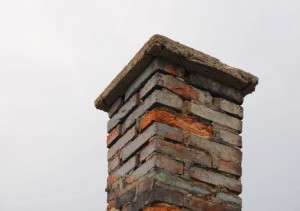During the warm months of summer, our chimneys fade into the background of our home, used as decorations instead of as heating appliances. Because of that, many homeowners fail to complete fireplace maintenance during the spring and summer – it simply slips their minds when their fireplaces are not in use.
 When the first true cold spell of winter hits, however, many homeowners are reminded that they did not have their chimneys swept, inspected, or repaired during the summer. This creates a fall rush as the chilly weather sets in and snow begins to fall. While it’s not too late to have your chimney swept before winter truly sets in, there are limitations to which and when repairs can be made when temperatures are colder. Click here to learn more about the chimney sweeping process.
When the first true cold spell of winter hits, however, many homeowners are reminded that they did not have their chimneys swept, inspected, or repaired during the summer. This creates a fall rush as the chilly weather sets in and snow begins to fall. While it’s not too late to have your chimney swept before winter truly sets in, there are limitations to which and when repairs can be made when temperatures are colder. Click here to learn more about the chimney sweeping process.
Why is chimney maintenance important?
Having annual chimney sweeps and inspections is one of the most important things homeowners can do to prolong to life of their chimney structure. “A chimney inspection is like an annual dental check-up,” says Ashley Eldridge, Director of Education for the CSIA. “It’s preventative maintenance that helps minimize potential hazards.”
The National Fire Protection Association recommends that “Chimneys, fireplaces, and vents shall be inspected at least once a year for soundness, freedom from deposits, and correct clearances. Cleaning, maintenance, and repairs shall be done if necessary.” During a sweep and inspection, certified technicians will evaluate the overall health of your chimney, checking the accessible parts of the interior and exterior and of the chimney. Likewise, they will clean the chimney structure, removing any buildup of creosote or other debris. If any damage is found, appropriate repairs will be recommended.
Water and masonry chimneys
Although chimneys are meant to stand against the elements, they do require annual maintenance and timely repairs to continue functioning. Even well maintained chimneys suffer due to the rain, sleet, snow, ice, and frigid temperatures of Minnesota winters. In chimneys with existing deterioration, the damage is only exacerbated.
When the bricks or mortar of a chimney become cracked, water is able to seep into the masonry. The masonry will then begin to quickly deteriorate as the water in the bricks goes through the freeze/thaw process; as temperatures drop, the water in the masonry freezes and expands, further damaging the brick. When the temperature rises again, the frozen water thaws, leaving more cracks and holes for additional water to enter. This process can cause a chimney to go from having only a few small cracks to crumbling apart in only a few short years.
Because water can cause chimneys to deteriorate so quickly, it is recommended to have repairs completed as soon as possible. It is equally important to call a chimney company at the first sign of chimney trouble, whether it is a foul odor, water in the firebox, or noticeable damage to the chimney structure. Because some chimney repairs cannot be done in cold weather, it is vitally important to get repairs finished as soon as possible.
If you have questions about the health of your chimney or need to schedule repairs before the weather gets any colder, contact Jack Pixley Sweeps today!
